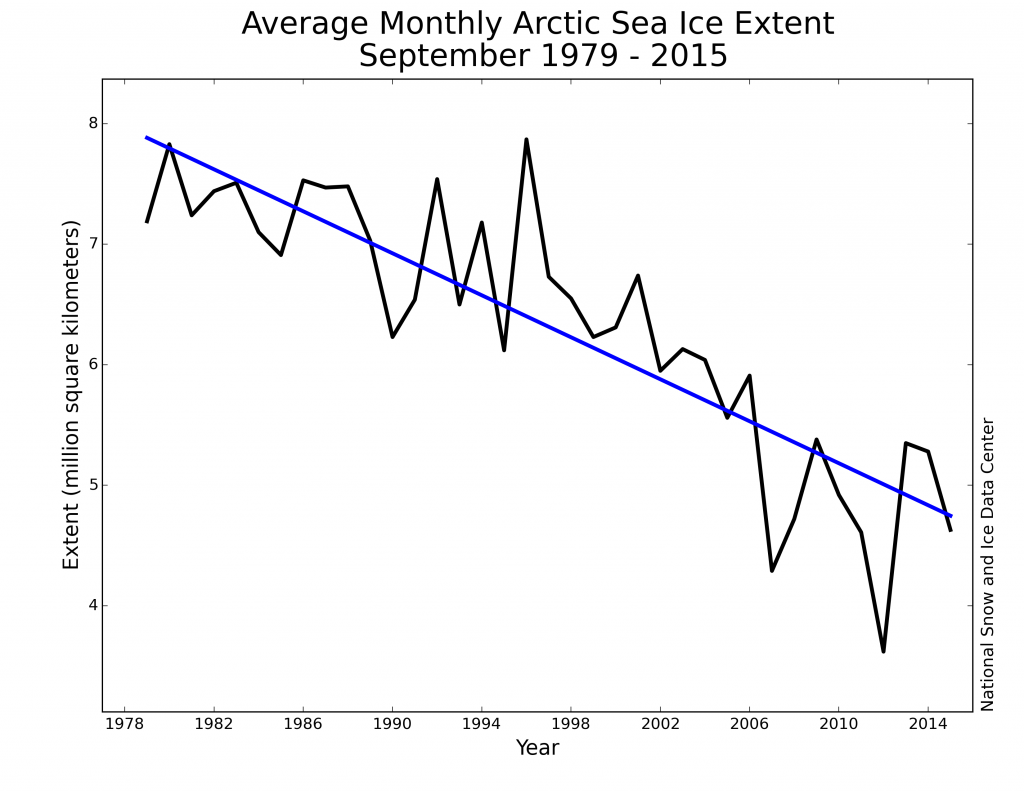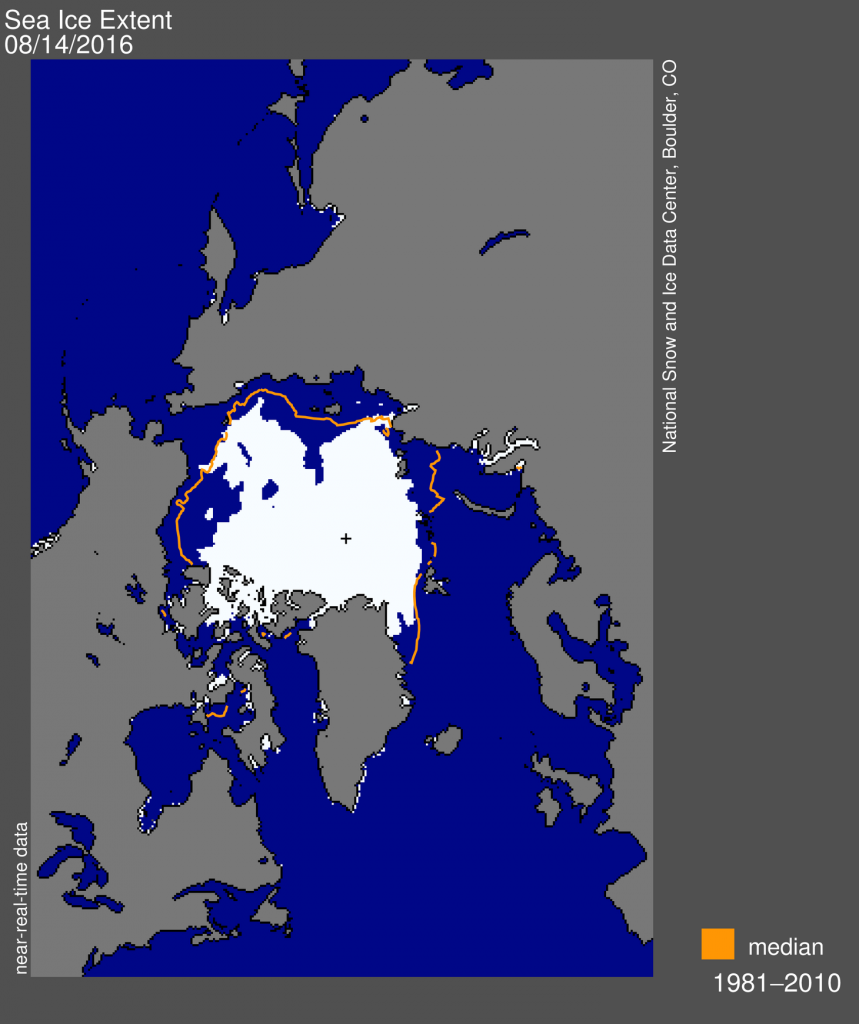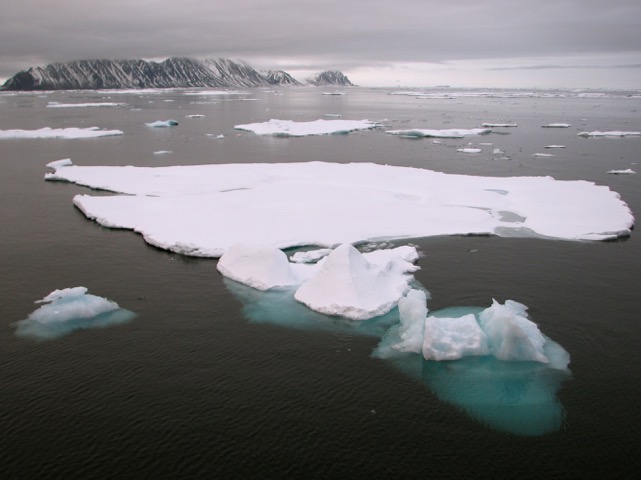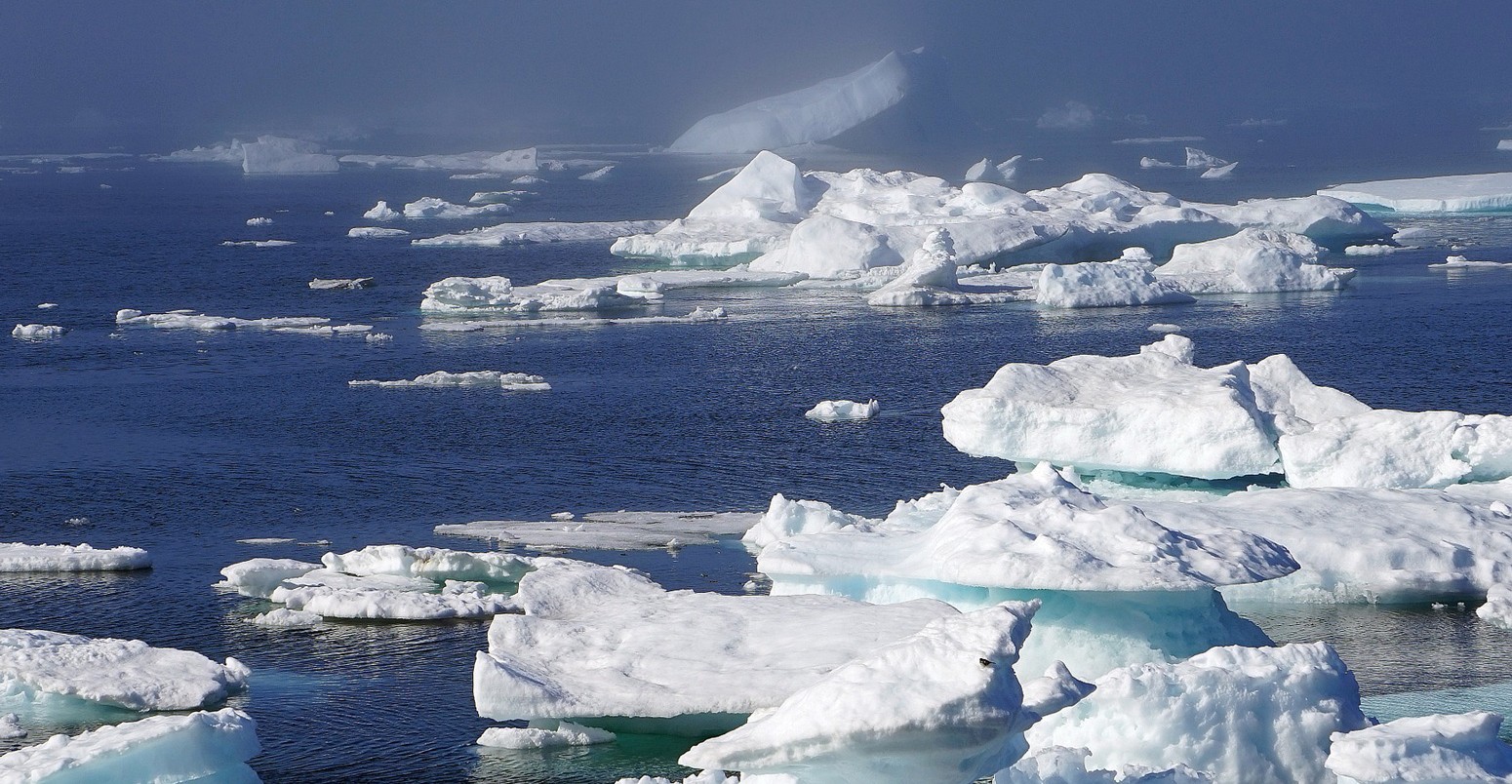Guest post: How predictable is the first ice-free Arctic summer?

Dr Alexandra Jahn
08.25.16
Dr Alexandra Jahn
25.08.2016 | 5:44pmA guest post by Dr Alexandra Jahn, Assistant Professor in the Department of Atmospheric and Oceanic Sciences and Fellow at the Institute of Arctic and Alpine Research at the University of Colorado.
Around this time each year, many people turn their attention to the Arctic in anticipation of the annual minimum for sea ice cover.
After reaching its annual peak extent at the end of winter, Arctic sea ice melts as temperatures rise through spring and into summer. Sea ice then hits its smallest extent sometime in September.
Since the satellite record began in 1979, the Arctic sea ice cover in September has declined by around 13% per decade. The current record low was recorded on 16 September 2012, when sea ice dwindled to 3.41m square kilometers.

Average monthly Arctic sea ice extent in September between 1979 and 2015 (at a rate of 13.4% per decade). Source: NSIDC
Such a stark drop off in sea ice has prompted the question of when the Arctic will first see an ice-free summer. In our new study, published last week in Geophysical Research Letters, we consider whether it’s possible to pin this down to a specific year.
When does ice-free mean ice-free?
First, we need to clarify what exactly an “ice-free” Arctic summer is.
By “ice-free”, scientists usually mean a sea ice extent of less than one million square kilometres, rather than zero sea ice cover.
There’s a good reason for this. Arctic sea ice isn’t just found in the central Arctic Ocean, but also along the northern coastlines of the US, Greenland, Russia and Canada, and in the narrow channels of the Canadian Arctic Archipelago. And it is thicker in these regions than in the central Arctic Ocean.
Scientists expect, therefore, that sea ice will be present there a little longer than it will out in the central Arctic Ocean. This means as sea ice continues to decline, we will reach a point where the central Arctic Ocean will be largely ice-free, but remnants of ice will still remain along the northern coastlines of Canada, Alaska, and Greenland. Scientists therefore chose the one million square kilometre threshold to represent a practically ice-free Arctic Ocean.

Arctic sea ice extent for 14 August 2016 (5.61m square kilometres). The orange line shows the 1981 to 2010 median extent for that day. The black cross indicates the geographic North Pole. Credit: NSIDC
It’s important to note that the one million square kilometre threshold is largely symbolic. Impacts from a more open Arctic Ocean – such as the decline of habitat for polar bears and other Arctic animals, the increase in coastal erosion, and the opening up of shipping routes – will take hold long before then.
Rather, like global temperature rise hitting 1C above pre-industrial levels, or atmospheric CO2 concentration reaching 400 parts per million, it’s a troubling milestone of human-caused climate change.
Uncertainty in predictions
Simulations from different climate models come up with a wide range of answers on when the Arctic could first become ice-free, with projections ranging from 2005 to after 2100. Most models suggest it will happen sometime around the middle of the 21st century.
Various studies have tried to narrow this range by selecting a subset of models that best reflect observations, or by correcting for model biases.
However, no study so far has asked the question of how much it is actually possible to narrow down these predictions. Just as weather forecasts are inherently limited by the chaotic nature of the atmosphere, climate projections have inherent uncertainties that limit the prediction accuracy we can achieve – even with the best models.

Sea ice in Baffin Bay. Credit: A. Jahn.
There are three principal sources of uncertainty in predictions of an ice-free Arctic summer: natural variability in the climate system, how quickly humans will tackle climate change by reducing greenhouse gas emissions, and model skill.
This year is a good example of how natural variability makes predictions tricky.
After an unusually warm winter, the Arctic sea ice maximum in March clocked in as the smallest in the satellite record. This led some to speculate that 2016 might be on course to beat the 2012 record low for the summer sea ice minimum. However, a period of cool and stormy weather during the summer means that is now highly unlikely. Arctic sea ice is now roughly tracking as the third lowest summer extent on record.
In our study, we tested how natural variability affects the long-term predictability of an ice-free summer, using a collection of 40 simulations of 21st century climate in an earth system model.
By running many simulations with slightly different initial conditions, we were able to assess the influence of natural fluctuations of the climate system on Arctic sea ice predictability. And we found that the uncertainty for Arctic sea ice predictions caused by natural variability amounts to around two decades.
This means that natural variability alone limits how close we can get to a prediction for an ice-free summer to a window of about 20 years.
Emissions pathways
Next, we considered the second source of prediction uncertainty – the rate of greenhouse gas emissions over the 21st century. The speed of sea ice melt in the Arctic will depend on how quickly we are able to cut global emissions and slow the pace of rising temperatures.
We compared model simulations under a pathway of high emissions (RCP8.5) to those under moderate emissions (RCP4.5). We found that the choice of emissions pathway added another five years to the uncertainty around predicting an ice-free summer.
Hence, considering two of the three main uncertainties of model predictions gives us a prediction uncertainty of around 25 years.
Our simulations put the first ice-free Arctic summer at some point between 2032 and 2053 for the high emission pathway, and between 2043 and 2058 for medium emission. However, this is the prediction uncertainty in just one model (the Community Earth System Model).
Model differences
As discussed earlier, models strongly disagree on when the Arctic could first be ice-free. The estimate of prediction uncertainty we have found is therefore at the low end of the scale – before differences in model physics and skill are considered.
It means that even if predictions of Arctic sea ice between models should agree better in the future, we will not be able to narrow down the prediction of an ice-free Arctic to less than 20 years due to natural variability. Or to less than 25 years when we factor in the uncertainty from different emissions pathways.
As an aside: the emissions pathways have a big impact on when we might see consecutive ice-free summers. For example, under the high emissions pathway, the Arctic is consistently ice-free during September from the late 2060s in our simulations. In contrast, under the moderate pathway, consistently ice-free summers only occur in a few model simulations by 2080.
In conclusion, our findings suggest that we cannot predict the timing of an ice-free Arctic summer with an uncertainty of less than about 25 years.
But while natural fluctuations of weather and climate will affect exactly when an Arctic summer will first be ice free, we can be fairly certain that it will happen well before the end of this century without significant cuts to greenhouse gas emissions.
This guest article is based on the following journal paper: Jahn, A. et al. (2016) How predictable is the timing of a summer ice-free Arctic?, Geophysical Research Letters, doi:10.1002/2016GL070067


